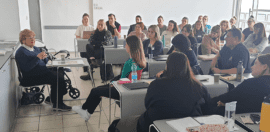New Stats on Indigenous Disadvantage ‘Alarming’

17 November 2016 at 11:48 am
The wellbeing of Australia’s Indigenous population continues to stagnate or even worsen in some areas despite some positive signs of improvement, according to a new Productivity Commission report.
The latest Overcoming Indigenous Disadvantage report, released on Thursday, shows a 77 per cent increase in imprisonment of Indigenous adults since 2000 and a 56 per cent increase in hospitalisation from self-harm attempts over the last decade.
The report said two years on from the previous report there continues to be improvement in many areas of health, economic participation and aspects of education.
“But areas such as justice and mental health remain concerning, with increases in imprisonment rates and hospitalisations for self-harm,” the report said.
Chair of the Productivity Commission and of the Steering Committee Peter Harris said the results were both encouraging and alarming.
“It is encouraging to see improvement over the last decade in rates of year 12 completion and post school education. But alarmingly the national imprisonment rate has increased 77 per cent over the last 15 years, and hospitalisation rates for self-harm have increased by 56 per cent over the last decade,” Harris said.
Productivity Commission deputy chair Karen Chester said: “If we are to see improvements in outcomes we need to know which policies work and why. But the overwhelming lack of robust, public evaluation of programs highlights the imperative for Indigenous policy evaluation.
“The OID report should be compulsory reading for anyone interested in the wellbeing of Aboriginal and Torres Strait Islander Australians, including those working in service delivery or program design.”
Around 3 per cent of the Australian population are estimated as being of Aboriginal or Torres Strait Islander origin (based on 2011 Census data).
Some of the key indicators from the report include:
- Mortality rates for children improved significantly between 1998 and 2014, particular for 0<1 year olds, whose mortality rates more than halved (from 14 to 6 deaths per 1000 live births).
- Education improvements included increases in the proportion of 20–24 year olds completing year 12 or above (from 2008 to 2014-15) and the proportion of 20–64 year olds with or working towards post-school qualifications (from 2002 to 2014-15).
- The proportion of adults whose main income was from employment increased from 32 per cent in 2002 to 43 per cent in 2014-15, with household income increasing over this period.
- The proportion of adults that recognised traditional lands increased from 70 per cent in 2002 to 74 per cent in 2014-15.
- Rates of family and community violence were unchanged between 2002 and 2014-15 (around 22 per cent), and risky long-term alcohol use in 2014-15 was similar to 2002 (though lower than 2008).
- The proportions of people learning and speaking Indigenous languages remains unchanged from 2008 to 2014-15.
- The proportion of adults reporting high levels of psychological distress increased from 27 per cent in 2004-05 to 33 per cent in 2014-15, and hospitalisations for self-harm increased by 56 per cent over this period.
- The proportion of adults reporting substance misuse in the previous 12 months increased from 23 per cent in 2002 to 31 per cent in 2014-15.
- The adult imprisonment rate increased 77 per cent between 2000 and 2015, and whilst the juvenile detention rate has decreased it is still 24 times the rate for non-Indigenous youth.
The report covered areas including governance and culture, early child development, health, education, economic participation and safe and supportive communities as well as reporting on indicators related to the Closing the Gap targets.
The 2016 OID main report, overview and short video can be found here.
The NSW Aboriginal Land Council (NSWALC) has called on governments to pay greater attention to the link between Aboriginal connection to land and improved outcomes in health, education and well-being following the release of the report.
NSWALC Chair Roy Ah-See said land was the key factor in healing and empowering Aboriginal people.
“The Productivity Commission report recognises what the Land Rights network in New South Wales already knows – that ownership and control of land and business delivers opportunities to increase income and create jobs that directly benefit Aboriginal peoples,” Ah-See said.
“The report also references the unique Land Rights system in New South Wales that allows Local Aboriginal Land Councils to claim certain Crown lands that are unneeded or not being used.
“This has empowered Aboriginal people to create and manage an economic base. Throughout the state, we have Local Aboriginal Land Councils engaged in property development and international tourism ventures. In many regional towns and centres they are the main providers of essential services.
“The NSW Aboriginal Land Council is also investing in the capacity of Local Aboriginal Land Councils through a $16 million five-year economic development strategy which is providing start-up capital and business development support for the network, as well as an Early Stage Investment Loans program.
“The return of land to Aboriginal people has provided new opportunities to strengthen us culturally and spiritually and to provide our own revenue streams, jobs and training opportunities.”








Imagine as an English speaking Anglo Saxon Australian you find yourself placed in Southern Africa forced to live with the Bushman tribal people. Language is different, food choices are strange, religion is foreign and excludes nature even the perception of poverty and success is polar opposite to yours. Now you have a picture of just a little of the experience of Indigenous Australians post 1788. Ancient Indigenous Australians have had a Core Value Belief system entrenched and passed down generationally for over 60,000 years – it is the polar opposite value system to Anglo Saxon ways of doing and being. Unfortunately, very few researchers and academics even measure or take into account Indigenous people’s belief system difference to gain a true account of Indigenous status. For example our perception of poverty is very different to Anglo Saxon Australia. We find richness in other things. The only time a report from Anglo Saxon Australia will show that Indigenous people are achieving success and well being in this country is when our Core Value belief system has been eradicated and we have taken on the value system of Anglo Saxons completely.